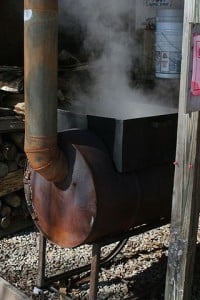California, comparatively speaking, has mild temperatures. That said, it is at this time, though – the beginning of November – that temperatures in the San Joaquin Valley if not elsewhere begin tumbling. What this points to is heightened wood-burning activity whether in fireplaces or woodstoves.
![Fireplace_Burning[1]](https://alankandel.scienceblog.com/files/2012/12/Fireplace_Burning1-300x225.jpg)
A principal emission associated with wood-burning activity is particulate matter. The greater the number of fireplace fires the higher the concentration of particulate matter in the outside air – which becomes much more pronounced with the presence of an atmospheric inversion layer which keeps said pollutant concentrations close to the ground; this is characteristic of the Valley, especially with its notorious wintertime fog.
Beginning in November 2014, in a year, a new wood-burning ban threshold in the Valley goes into effect. It is to go from its current 30 micrograms per cubic meter of air limit to 20 micrograms per cubic meter of air. What this means is when the concentration of particulates exceeds 20 micrograms per cubic meter, the wood-burning restrictions will be in effect or, wood-burning will be prohibited, in other words. The threshold is applied daily from Nov. 1st to Feb. 28th. Historically, not everyone has complied with the rules.
More importantly, perhaps, is a new national annual ambient air quality standard for fine particle pollution.
In “California’s ‘Big Valley’ committed to improved air quality – big time!” I pointed out that the new U.S. Environmental Protection Agency standard will be more protective of human health, going from its current 15 micrograms to 12 micrograms per cubic meter of air threshold. The former standard was instituted in 1997.
What all this sounds like is the effort to clean up fine particulates in the San Joaquin Valley, California and across the country is being stepped up.

Nevertheless, I know that when wood smoke spewing out of neighborhood chimneys reaches concentrations that cause surrounding air to become unpleasant to breathe in, what this suggests is that such smoke becomes more than just an irritation; it presents an increased danger to human health and, presumably, this means such presents an increased risk to those who suffer from respiratory illness.
When such conditions exist, it is during these times that I refrain from using my home’s interior heating system because of its tendency to draw outside air indoors. I don’t use my fireplace either.
For more, see: “Can PM 2.5 lead to early mortality?”
– Alan Kandel